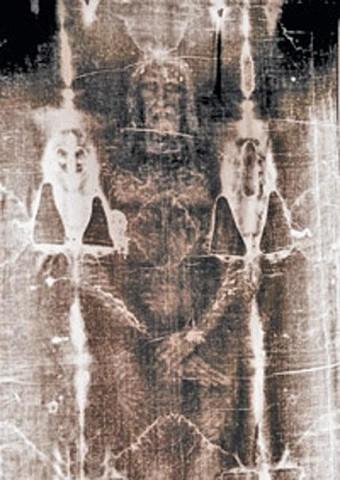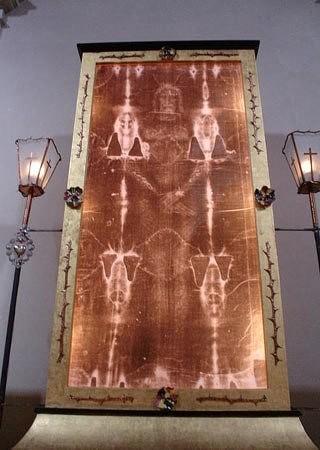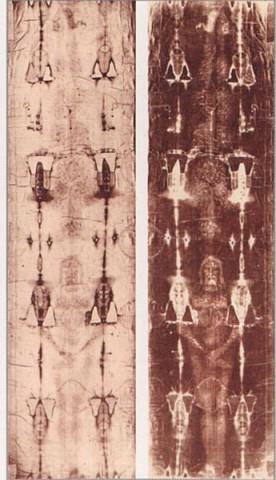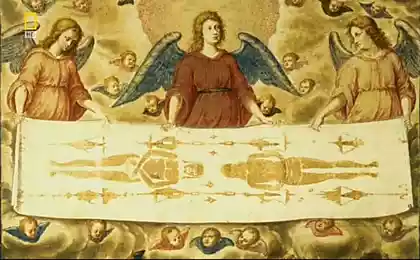925
MYSTERY Shroud of Turin.

The Shroud of Turin (ital. Sindone di Torino) - Christian relic, four-meter linen, in which, according to legend, Joseph of Arimathea wrapped the body of Jesus after his sufferings on the Cross and death (Mf.27: 59-60).
Many Christians believe that the Shroud imprinted image of Christ. Unfortunately believers, the Vatican has not officially recognized the authenticity of the shroud, and the academic world and all Christian holiness relates to forgery.
It is known that up to 1204 the Shroud was kept in the church of Hagia Sophia in Constantinople, and was exhibited to show every Friday and the entire Holy Week.
For the first time the relic recorded in France in 1353: Zheffrua de Charny announced that the shroud is from him. Initially, the Shroud was exhibited in the town of Lira in the realm of de Charny. In 1452, the granddaughter of Count Margarita sells Christian shrine Duke Louis I of Savoy. He kept it in the cathedral city of Chambery, where in 1532 there was a fire. Of course, the Shroud was severely damaged. After the capital was moved to Turin Shroud has moved to the Cathedral of St. John the Baptist, where it is kept to this day.
But why the authenticity of the Shroud came under question? Since the Vatican all understandable, because the higher clergy prefers to rely only on the texts of the Bible, despite the fact that the translation is far from the truth.
Also, in terms of descriptive geometry, if captured tissue surround the imprint of man, its unfolding is to show a distorted image of the face and body, however on the shroud is not observed, representing it as a flat projection of man. The projection of man from the back side by as much as 5 cm higher than the projection on the front.
It is known that after the purchase in 1452 by Louis of Savoy shroud, she disappeared for fifty years. What happened in the meantime, unfortunately, nobody knows. But everyone knows that in this period there was a great scientist Leonardo da Vinci.
American artist Lillian Schwartz, nominated his hypothesis that the "Mona Lisa" is a self-portrait of Leonardo, made a computer analysis of the paintings and the mysterious face of Turin shrine. The result was stunning - Christ appeared almost a mirror image of the Mona Lisa, ie Leonardo da Vinci.
According to scientists, a great artist could really recreate the like. At that time already it had the opportunity to use the technology, which was the prototype of modern photography. In support of this theory, there is the fact that in the works of Leonardo's drawings are a primitive device for photographing.
However, late in the last century of research interest were still produced. One of the most important tasks was to determine the age of the web by radiocarbon analysis. The studies were conducted with sampling in independent laboratories in Arizona, Oxford and Zurich. The results are close date ranges, within the XII-XV centuries AD. Later, these conclusions have been challenged. There was an assumption that the samples for analysis were taken not from the underlying tissue, and with patches imposed during one of the repairs.
The theories are many, but it's all the assumptions of single researchers who also require evidence. Therefore, to date, it is to trust only the results of radiocarbon dating conducted in three independent laboratories.
There is a strong likelihood that Turin is kept a copy of the famous paintings.
Speaking May 24, 1998 in Turin before the pilgrims gathered at the Shroud, Pope John Paul II said that it affects the extent to which the relevant data that the researchers obtained the Shroud, the Gospel text. He particularly appealed to the scientists, saying that the Church expects them to continue their studies. "The Church invites science - said John Paul II, - act with inner freedom and at the same time respectful, because it is such an attitude is characteristic for both scientific methodology and for the feelings of believers."
The mystery of the Shroud of Turin concerned scientists and believers all over the world for a long time, but has not yet given a definite answer about the nature of one of the main Christian shrines. Shroud of Turin exhibit on display pilgrims once in 25 years. The last time it could see more than a million people. The next time you see the symbol of the Christian faith will only be possible in 2025.




























